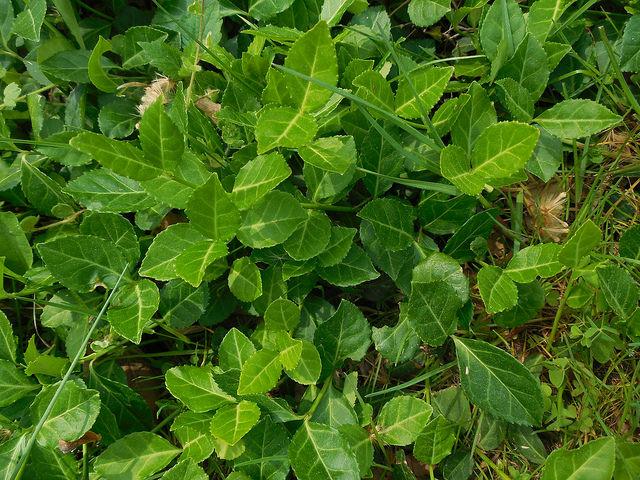From Summer 2023 issue of Branching Out. Subscribe to Branching Out here. Read more Invasives in Your Woodland articles here. This article contains information current as of date of publication.
The name “Winter Creeper” suggests that the focus of this issue’s spotlight might grow slowly during the season between autumn and spring. That may have been true in its native habitat in Asia. A general search turns up no particular origin story connected to its name aside from its Latin name (euonymus Fortunei), which is in recognition of the Scottish botanist and explorer Robert Fortune. It is known, however, that the plant was imported to the United States in 1907 as an ornamental ground cover.
In that role, it performs well, and grows vigorously to fill open spaces. But this quality, along with its tolerance of harsh conditions, allowed it to escape from cultivation and to spread throughout much of the eastern states. In Maryland, it is reported in all but three counties (Garrett, Charles, and St. Mary’s). See the map below. Consequently, it has been banned for sale by the state Department of Agriculture as a Tier 1 invasive plant.

What is it?
Winter creeper, also known as wintercreeper, creeping euonymus, or Fortune’s spindle, is an evergreen perennial vine. As noted above, it is a vigorous plant, and it tolerates a wide range of soil types. It grows well in conditions from full sun to deep shade and in soils that are acidic or low in nutrients. It does poorly, however, in heavy wet soils. It can create dense mats and thickets that shade out native plant species, or grow as shrubs up to 3 feet tall.
This vine invades both forest margins and disturbed areas, such as where construction has taken place or where new landscaping has occurred, as well as forest openings that have been created by windstorms, fire, or mechanical thinning.
How does it spread?
Winter creeper can grow along the ground as well as climb into trees. The ground-based vines spread vegetatively, sending out new roots laterally along the main branches to create new plants. Vines that encounter trees may climb to over 60 feet above the ground in search of sunlight. Researchers note that these lead to different behaviors, as apparently only juvenile vines will spread onto trees, and only those that climb produce flowers and fruit when they mature. The fruit can be consumed by birds and wildlife, which then excrete the seeds that colonize new areas.
How can I identify it?
The vines' two growth environments mean winter creeper has two different forms of leaves. While both are dark green, glossy ovals with silvery veins and toothed margins, growing opposite on the stem, the type of oval varies. Leaves of vines growing into the trees are more elongated.
Mature climbing vines can produce flowers in June and July and fruit in the fall. The flowers are small and greenish with five petals. The fruit are small pink-red capsules that split to expose the seeds. See the image gallery below.
How can I control it?
If possible, remove young plants as soon as they are found. Hand-pulling or grubbing with a Pulaski or other tool is effective if the soil is moist and if all roots can be removed. Herbicide applications can be effective when used properly. Cut-stem treatments can kill the vines in trees, and foliar treatments are effective in low-lying infestations.
For more information:
Learn more about winter creeper:
Climbing Euonymus (Plant Conservation Alliance)
Look out for wintercreeper (Maryland Grows Blog)
Evergreen and Creepy: It’s Winter Creeper! (Virginia Native Plant Society)
 English
English العربية
العربية Български
Български 简体中文
简体中文 繁體中文
繁體中文 Hrvatski
Hrvatski Čeština
Čeština Dansk
Dansk Nederlands
Nederlands Suomi
Suomi Français
Français Deutsch
Deutsch Ελληνικά
Ελληνικά हिन्दी
हिन्दी Italiano
Italiano 日本語
日本語 한국어
한국어 Norsk bokmål
Norsk bokmål Polski
Polski Português
Português Română
Română Русский
Русский Español
Español Svenska
Svenska Català
Català Filipino
Filipino עִבְרִית
עִבְרִית Bahasa Indonesia
Bahasa Indonesia Latviešu valoda
Latviešu valoda Lietuvių kalba
Lietuvių kalba Српски језик
Српски језик Slovenčina
Slovenčina Slovenščina
Slovenščina Українська
Українська Tiếng Việt
Tiếng Việt Shqip
Shqip Eesti
Eesti Galego
Galego Magyar
Magyar Maltese
Maltese ไทย
ไทย Türkçe
Türkçe فارسی
فارسی Afrikaans
Afrikaans Bahasa Melayu
Bahasa Melayu Kiswahili
Kiswahili Gaeilge
Gaeilge Cymraeg
Cymraeg Беларуская мова
Беларуская мова Íslenska
Íslenska Македонски јазик
Македонски јазик יידיש
יידיש Հայերեն
Հայերեն Azərbaycan dili
Azərbaycan dili Euskara
Euskara ქართული
ქართული Kreyol ayisyen
Kreyol ayisyen اردو
اردو বাংলা
বাংলা Bosanski
Bosanski Cebuano
Cebuano Esperanto
Esperanto ગુજરાતી
ગુજરાતી Harshen Hausa
Harshen Hausa Hmong
Hmong Igbo
Igbo Basa Jawa
Basa Jawa ಕನ್ನಡ
ಕನ್ನಡ ភាសាខ្មែរ
ភាសាខ្មែរ ພາສາລາວ
ພາສາລາວ Latin
Latin Te Reo Māori
Te Reo Māori मराठी
मराठी Монгол
Монгол नेपाली
नेपाली ਪੰਜਾਬੀ
ਪੰਜਾਬੀ Afsoomaali
Afsoomaali தமிழ்
தமிழ் తెలుగు
తెలుగు Yorùbá
Yorùbá Zulu
Zulu ဗမာစာ
ဗမာစာ Chichewa
Chichewa Қазақ тілі
Қазақ тілі Malagasy
Malagasy മലയാളം
മലയാളം සිංහල
සිංහල Sesotho
Sesotho Basa Sunda
Basa Sunda Тоҷикӣ
Тоҷикӣ O‘zbekcha
O‘zbekcha አማርኛ
አማርኛ Corsu
Corsu Ōlelo Hawaiʻi
Ōlelo Hawaiʻi كوردی
كوردی Кыргызча
Кыргызча Lëtzebuergesch
Lëtzebuergesch پښتو
پښتو Samoan
Samoan Gàidhlig
Gàidhlig Shona
Shona سنڌي
سنڌي Frysk
Frysk isiXhosa
isiXhosa